10 Key Features for Your Customer Portal
According to a recent Zendesk study, 73% of customers would switch brands they use due to a poor customer service experience. Modern clients seek convenience and high-quality support, making a well-crafted customer portal an invaluable business asset.
A web-based customer portal allows users to keep in touch with a business 24/7 by submitting requests, resolving issues, browsing products and services, making purchases, and more. All these make customer portals indispensable for industries that work with finances, online retailers, and healthcare providers.
In this guide, we’ll discuss the 10 must-have customer portal features your company needs to stay ahead of the competition.
One of the most essential customer portal features is onboarding. It covers the initial period of the customer’s journey on the website, from registration to the first interactions with the portal. The onboarding process is supposed to make the transition as smooth as possible, ensuring users can navigate the portal’s features quickly and effectively.
Consider these elements when developing the onboarding process:
- Guided tours and tutorials to familiarize the users with the portal’s features.
- Role assignment to categorize users based on responsibilities and access levels.
- Personalized user dashboards to display relevant information based on the user’s preferences.
- Clear communication channels such as welcome emails, in-app notifications, and pop-up guides.
- Security measures such as two-factor authentication to ensure maximum security.
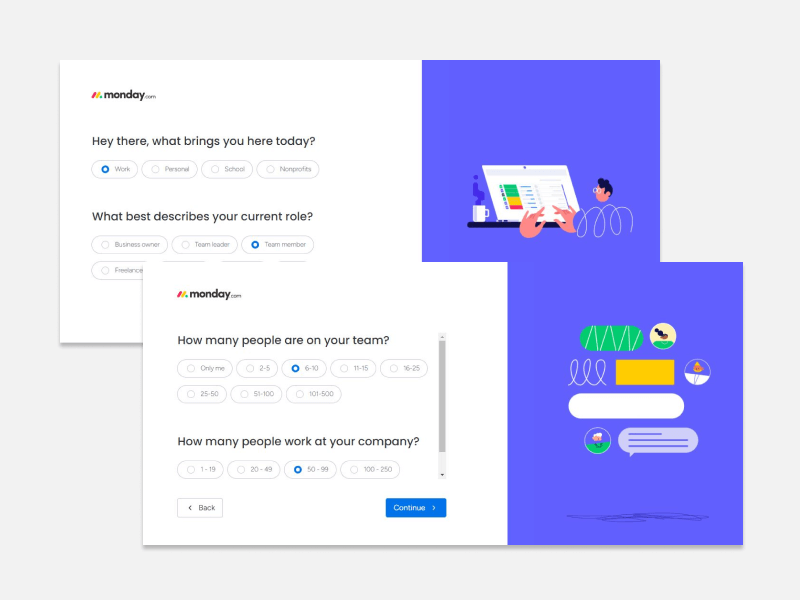
Interactive onboarding on a project management platform. Image credit: Monday.com.
Notifications and alerts are among the key customer portal features to keep users engaged and inform them about updates, new offerings, and changes in their accounts. Ideally, notifications enhance user experience by providing timely information and assisting decision-making.
Include the following features to maximize the use of notifications in your portal:
- Customizable notification preferences to ensure users control what alerts they get.
- Event-specific notifications that inform users about relevant activities like order updates, account changes, or new promotions.
- Real-time alerts to ensure time-sensitive information is delivered immediately.
- Notification history that allows users to review past notifications and track the history of events.
- Smart alerts prioritized based on their importance, seeding out critical alerts from general updates.
One of the popular features of a modern customer portal is using self-service capabilities. It is necessary to reduce the load on your support agents and help users find solutions on their own. However, remember that a self-service web portal isn’t a full alternative to customer support.
Here are some features of client portal’s self-service section:
- Knowledge bases that include articles, guides, and tutorials addressing common questions.
- Frequently Asked Questions (FAQs) around various sections of the portal with clear and concise answers.
- Customer forums or discussion boards where users can interact with each other and solve issues.
- Reviews and feedback forms where clients can share their experiences with your team.
- Integration with smart self-service tools such as chatbots, virtual assistants, and others.
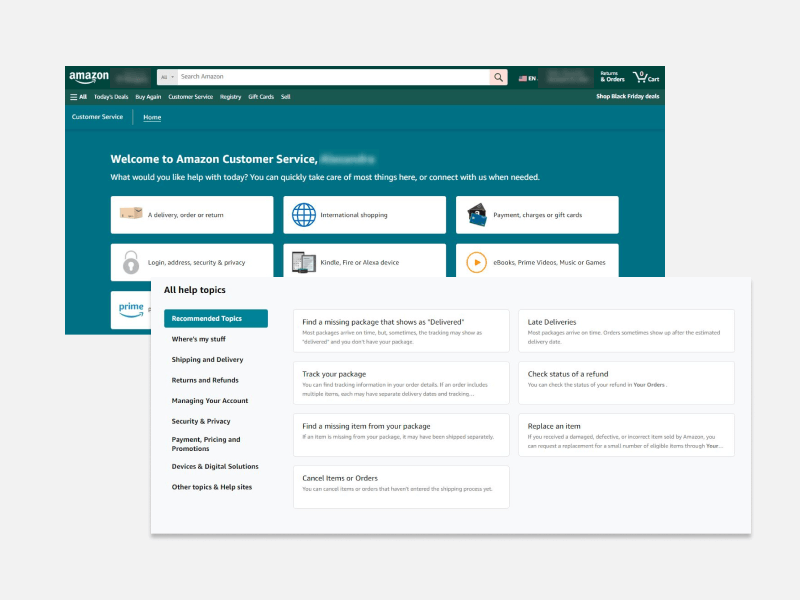
Self-service features for Amazon customers. Image credit: Amazon.
A personalized shopping experience is one of the main capabilities of customer portals. This feature enables businesses to tailor the products and services they showcase to suit each individual customer’s preferences. It enhances customer satisfaction and increases the chance of repeated sales.
Consider using the following elements in this feature:
- Dynamic catalog with easy navigation and categorization, detailed descriptions, and high-quality images to improve the user’s shopping experience.
- Personalization algorithm that analyzes customer behavior, purchase history, and preferences to generate personalized product recommendations, discounts, and offers.
- Promotional campaign management that allows businesses to set discounts, create bundled offers, and use other promotional strategies with their marketing efforts.
- User-specific pricing that allows companies to set different pricing tiers and discounts based on customer segments, loyalty levels, and other criteria.
Ensuring that the users have access to seamless transactions is integral for building a good customer portal. Integrating the most popular payment systems into your platform is a great option to cover all possible audiences. Users will be more likely to make a purchase if the process is fast and easy.
Note these points to develop a robust online payment and invoicing feature:
- Integrations with payment systems like PayPal, Stripe, Apple Pay, Google Pay, and others.
- Automated invoicing to reduce manual efforts and ensure customers receive billing info on time.
- Subscriptions and recurring payments for memberships, regular purchases, or subscription-based models.
- Transaction history and receipts to provide customers with access to this data.
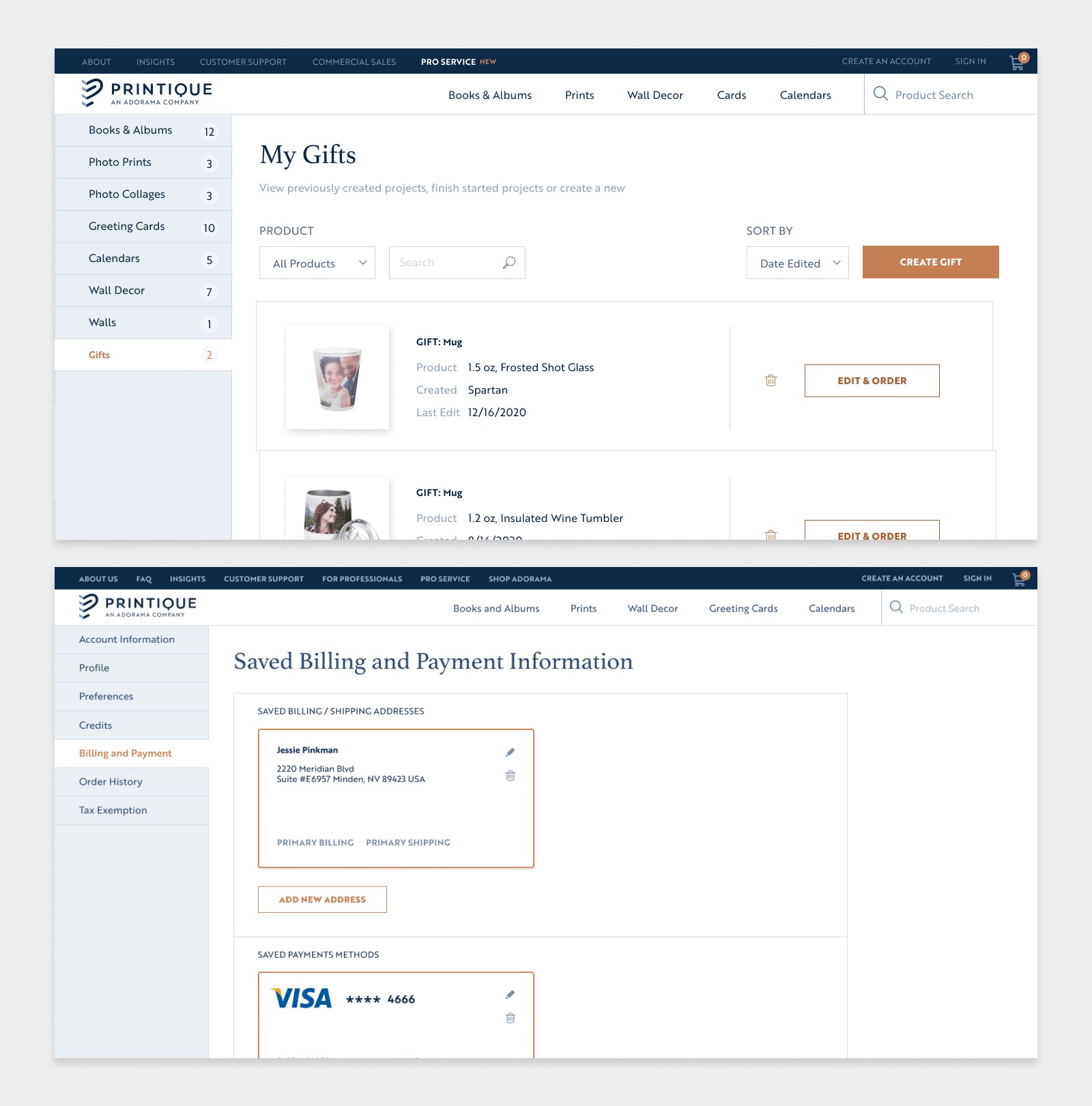
Secure online payment and billing features.
Another one of the top customer portal features is seamless integration with third-party software that enhances the platform’s usability and convenience. Having everything in a single resource is a significant advantage compared to when you need a dozen different resources for daily operations.
Consider using these integrations in your software:
- CRM to synchronize customer data, interactions, feedback, and more.
- ERP to facilitate data exchange between the software and manage tasks.
- Inventory management system to have real-time data on product availability, restocking updates, and accurate inventory levels.
- Order and shipping tracking to provide customers with visibility into their orders.
Considering their indispensability, content management tools are the main customer portal features. The ability to update, modify, and organize content efficiently ensures that the portal provides users with relevant and updated information.
Here are some features to add to your customer portal’s content management system:
- User-friendly interface to make it simple to create, edit, and organize content.
- Version control to track changes and revert to previous versions if necessary.
- Multimedia support to create engaging and dynamic content with images, videos, and more.
- Content personalization capabilities based on user segments, roles, and other criteria.
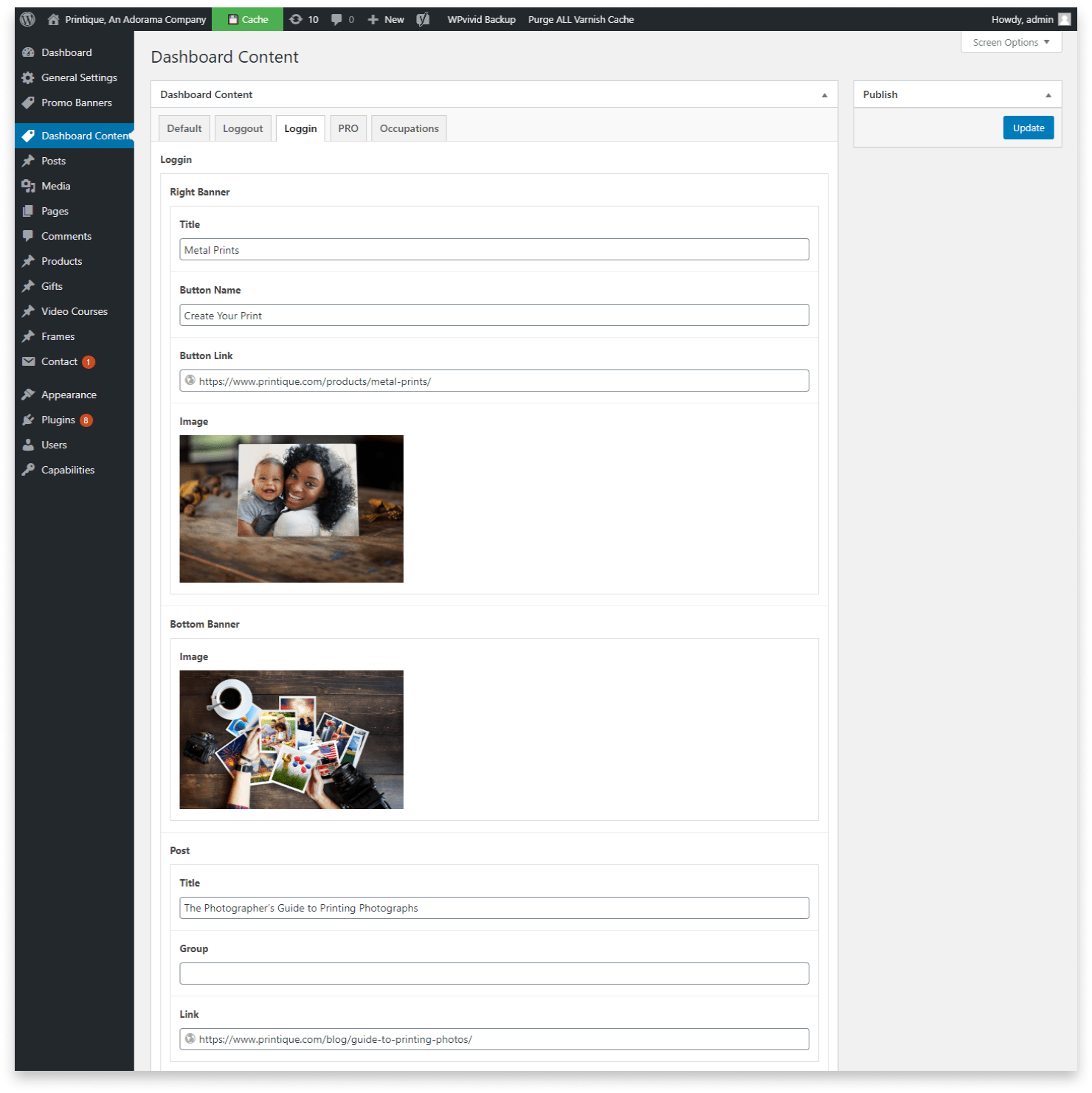
WordPress content management to easily create, edit, and publish content.
Your customer portal’s functionality must include a robust customer support system to help users whenever it is needed. Whether you prefer a traditional help deck approach or want to delegate a large portion of the process to automation, this feature is essential for the survival of your company. People are likely to switch to another portal if you are unable to provide a high-quality service, so it’s important that you pay enough attention to this feature.
Consider integrating the following:
- Live chat to provide instant help within the portal.
- Knowledge base to let users find the needed info on their own.
- Integration with customer support services and ticketing system to let users submit inquiries, issues, or requests for assistance.
Slash your customer support costs
Build an effective customer portal to enhance customer experience and reduce support and operating costs.
PORTAL DEVELOPMENT SERVICESE-commerce often requires businesses to upload, share, and sign digital documents. That’s why document sharing and management is one of the features of the customer portal you need to take into account.
Here’s what this feature should include:
- Integration with e-signature tools like DocuSign.
- Secure upload using encryption and security protocols.
- File format compatibility to support various forms from PDFs to spreadsheets.
- Document sharing and collaboration to ensure parties can access the same files if needed.
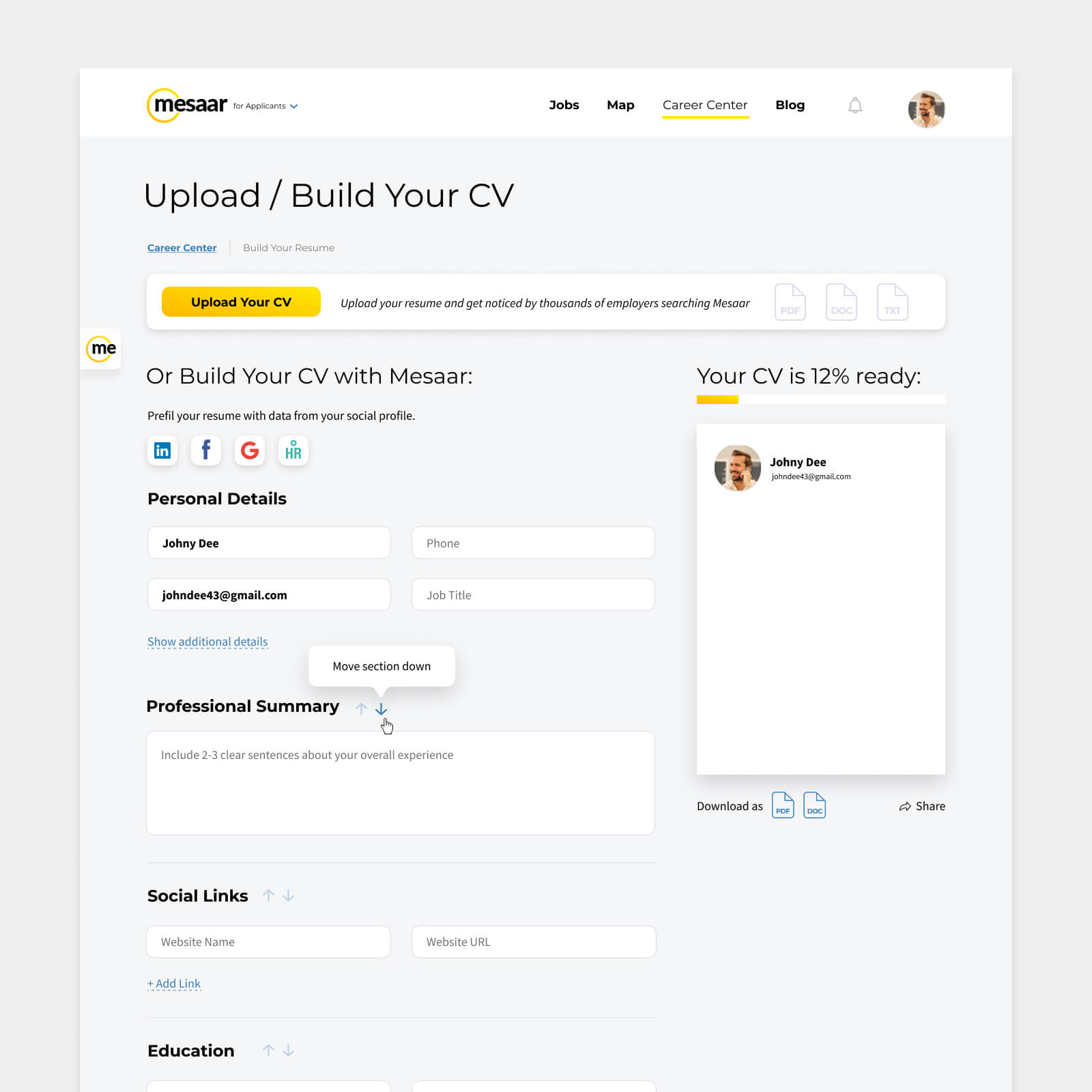
Document upload and sharing on a customer portal for job seekers.
When listing the most important features for a customer portal, we cannot omit order tracking and management. Customers must be aware of what’s going on with their orders to monitor them and apply changes whenever needed.
Include the following features to make it effective:
- Real-time tracking to provide visibility into the status and location of orders.
- Order history to show previous orders.
- One-click reordering to simplify the repurchasing process.
- Order scheduling to make it easy to set up future purchases.
Build a feature-rich customer portal with Digiteum
Leverage our decade-long experience in custom web development to design and build an intuitive feature-rich web portal for your customers and integrate it into your business process. Since 2010, we have been supporting our clients, including Oxford University Press, Diaceutics, Adorama Camera, Lodgify, Origin Digital, and dozens of other successful companies in logistics, retail, healthcare, education, and tech, helping them future-proof their operations and adopt modern web technologies. Among some of the projects we are proud of are:
- A web system for a leading photo print service provider that includes B2B and B2C customer portals, dozens of unique online product designers and features, integrations with third-party and in-house systems for product management, shipping, payment processing, customer support, CRM, and analytics, and a complete set of eCommerce features. Read the full success story…
- A fundraising campaign management platform that includes an interactive customer portal to create and manage campaigns for various channels, secure payment gateway, document management, campaign tracking and analytics. Read the full success story…
Empower your customers, fuel your business
Provide your customers with superior experience tailored to their needs and the unique requirements of your business.
HIRE PORTAL DEVELOPERSWrap-up
This checklist provides a comprehensive set of customer portal features. It is important, however, to select the right functionality and prioritize features to address the unique requirements and goals of your customers. If you need help choosing a powerful feature set and developing an effective web portal for your customers, contact our team.







